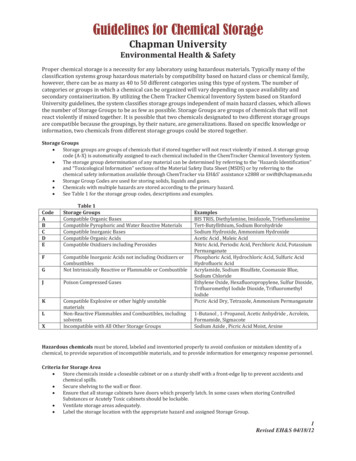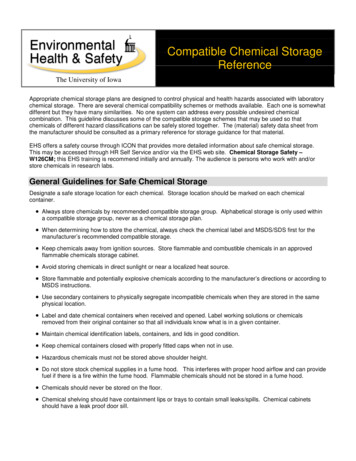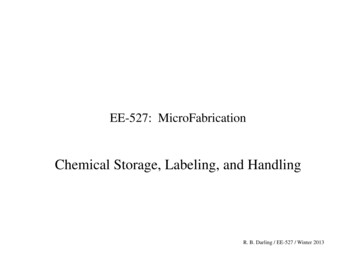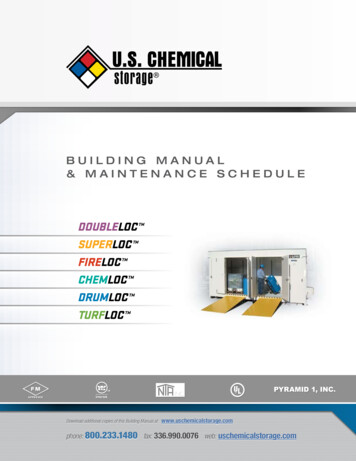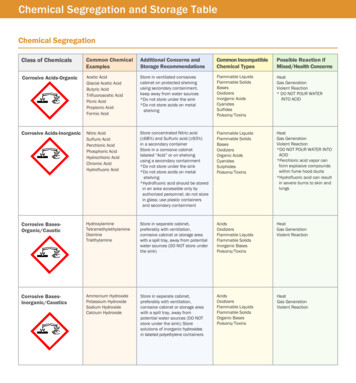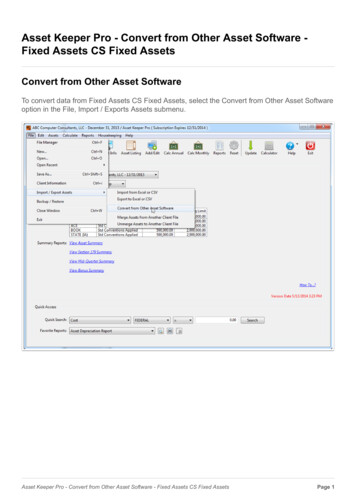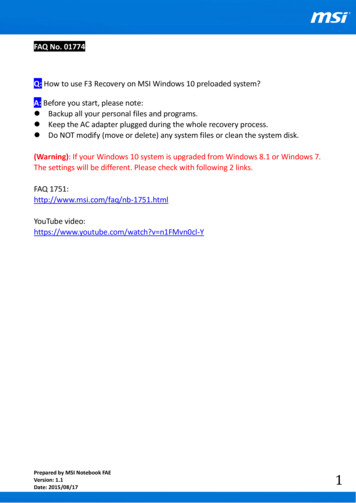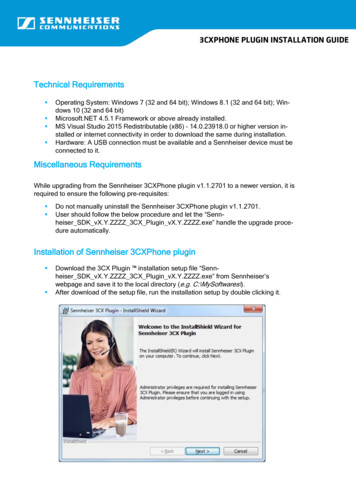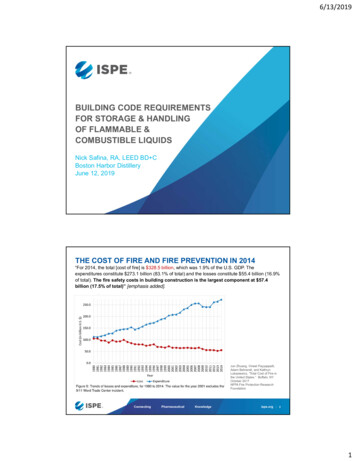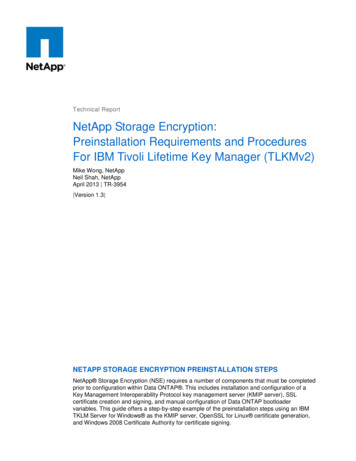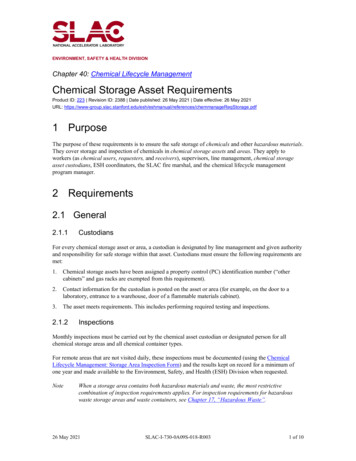
Transcription
ENVIRONMENT, SAFETY & HEALTH DIVISIONChapter 40: Chemical Lifecycle ManagementChemical Storage Asset RequirementsProduct ID: 223 Revision ID: 2388 Date published: 26 May 2021 Date effective: 26 May 2021URL: references/chemmanageReqStorage.pdf1 PurposeThe purpose of these requirements is to ensure the safe storage of chemicals and other hazardous materials.They cover storage and inspection of chemicals in chemical storage assets and areas. They apply toworkers (as chemical users, requesters, and receivers), supervisors, line management, chemical storageasset custodians, ESH coordinators, the SLAC fire marshal, and the chemical lifecycle managementprogram manager.2 Requirements2.1 General2.1.1CustodiansFor every chemical storage asset or area, a custodian is designated by line management and given authorityand responsibility for safe storage within that asset. Custodians must ensure the following requirements aremet:1.Chemical storage assets have been assigned a property control (PC) identification number (“othercabinets” and gas racks are exempted from this requirement).2.Contact information for the custodian is posted on the asset or area (for example, on the door to alaboratory, entrance to a warehouse, door of a flammable materials cabinet).3.The asset meets requirements. This includes performing required testing and inspections.2.1.2InspectionsMonthly inspections must be carried out by the chemical asset custodian or designated person for allchemical storage areas and all chemical container types.For remote areas that are not visited daily, these inspections must be documented (using the ChemicalLifecycle Management: Storage Area Inspection Form) and the results kept on record for a minimum ofone year and made available to the Environment, Safety, and Health (ESH) Division when requested.NoteWhen a storage area contains both hazardous materials and waste, the most restrictivecombination of inspection requirements applies. For inspection requirements for hazardouswaste storage areas and waste containers, see Chapter 17, “Hazardous Waste”.26 May 2021SLAC-I-730-0A09S-018-R0031 of 10
SLAC National Accelerator LaboratoryEnvironment, Safety & Health DivisionChemical Lifecycle Management Chemical Storage Asset Requirements2.1.3Secondary ContainmentSized secondary containment is required for storage assets when any single container is in excess of 55gallons of liquid, 550 pounds for solids, or when the aggregate capacity of multiple vessels exceeds 1,000gallons (10,000 pounds for solids). (See Hazardous Materials Storage Secondary Containment Guidelines[UN-083].) Line management is responsible for ensuring sized secondary containment is in place whereneeded.2.2 Bulk Storage TanksBulk storage tanks are used at SLAC to store many materials including liquid nitrogen, helium, watertreatment chemicals (acids, bases, and proprietary treatment chemicals), propane, and fuel. The installationof bulk storage tanks for chemicals requires a design review through the ESH Building Inspection Officebefore purchase or installation (see ESH: Project Review Procedure). This review evaluates issues such assiting, material compatibility, safety controls, hazard communication signs, pressure relief, seismic design,security, and fire protection. Appropriate industrial standards will be incorporated into the design of thistype of storage asset.2.3 Tube TrailersTube trailers contain 20 to 40 long, horizontal, compressed gas cylinders (CGCs) bundled together andconnected by manifolds for ease of use, transport, and safety. SLAC uses tube trailers for managinghydrogen and helium. .It is a Department of Transportation (DOT) requirement that tube trailers that are in commerce (that is, willbe transported over public roads) must be pressure-tested every five years. It is the responsibility of thecustodian to arrange for this testing with the assistance of the on-site CMS provider. Hydrostatic tests mustbe conducted by a qualified testing facility.2.4 Storage CabinetsAll chemical storage cabinets must meet the following minimum requirements: Doors must be well fitted, equipped with a latch, and self-closing. (Cabinets in continuous use andmeeting the fire code at the time of purchase may be used even if not self-closing, but if not in usemust be updated or replaced to meet current fire code requirements.) Cabinets must be seismically braced to a sound structure to prevent dislodgement during anearthquake. The seismic bracing must not penetrate the cabinet in such a way that it would facilitaterelease of the chemical from the cabinet. The SLAC fire marshal approves seismic bracing of chemicalcabinets to ensure the bracing does not compromise the cabinet listing. Cabinets including contentsthat weigh 400 pounds or more must have engineered restraints. The bottom of the cabinet must be liquid tight to a height of at least two inches (50.8 mm). The cabinet, including the door, must be double walled, with 1.5 inch (38.1 mm) airspace between thewalls. Joints must be riveted or welded and tight-fitting.26 May 2021SLAC-I-730-0A09S-018-R0032 of 10
SLAC National Accelerator LaboratoryEnvironment, Safety & Health DivisionChemical Lifecycle Management Chemical Storage Asset Requirements Cabinets must be constructed of metal and must be listed by an accredited listing agency. Unlistedcabinets may be used if approved by the SLAC fire marshal and they–Are constructed from steel with a thickness of at least 0.044 inch (1.12 mm) (18 gauge)–Meet all the requirements of a listed cabinetApproved and rated chemical storage cabinets will not be used for ordinary (non-hazardous) storage.2.4.1Flammable Container Storage CabinetsFlammable liquid in quantities greater than 10 gallons per work area 1 must be stored in chemical storagecabinets that meet the design requirements of the California Fire Code, chapters 27 through 41 (24 CCR2701–4101) and the Flammable and Combustible Liquids Code (NFPA 30). Cabinets used to storeflammable liquids must meet the following requirements in addition to those in Section 2.4: The combined total of all liquids will not exceed 120 gallons (454 L). Cabinets used to store flammable liquids must be provided with a conspicuous label in red letters oncontrasting background that reads FLAMMABLE–KEEP FIRE AWAY. Combustible material (wood shelves added after purchase, cardboard boxes and paper) should beminimized or eliminated. The number of flammable liquid storage cabinets and quantity of flammable materials allowed in abuilding is regulated and determined by occupancy codes, space between cabinets, and whether thebuilding is equipped with sprinklers. Contact the SLAC fire marshal for details.2.4.2Corrosive Material Storage CabinetsCabinets used to store corrosives must meet the following requirements in addition to those in Section 2.4: Incompatible corrosives must not be stored in the same cabinet without containment. All corrosive storage cabinets must be conspicuously labeled (letters on contrasting background) withCORROSIVE – ACID or CORROSIVE – BASE. Cabinets must be treated or coated on the interior with a material that is non-reactive with thehazardous material stored, and this treatment or coating must cover the entire interior of the cabinet. The quantity of corrosive materials allowed in a building is regulated and determined by occupancycodes, space between cabinets, and whether the building is equipped with sprinklers. Contact theSLAC fire marshal for details.2.4.3Laboratory Hoods with Built-in Storage CabinetsBuilt-in flammable liquid and corrosive material storage cabinets in laboratory hoods are subject to therequirements above for storage cabinets.Note1For requirements regarding electrical equipment and devices within cabinets used for thestorage of flammable chemicals, see the National Electrical Code (NFPA 70), Section 500.A work area is a use area, defined as a contiguous area that is controlled and used by one work groupin reference to the exemption in 24 CCR Part 9, Section 3404.3.4.4, “Liquids for Maintenance andOperation of Equipment” (24 CCR 3404.3.4.4).26 May 2021SLAC-I-730-0A09S-018-R0033 of 10
SLAC National Accelerator LaboratoryEnvironment, Safety & Health DivisionChemical Lifecycle Management Chemical Storage Asset Requirements2.4.4Chemical RefrigeratorsOrdinary domestic refrigerators and freezers must not be used for storing flammable liquids due toexposure to electrical components (light bulbs, switches, contacts and motors) that can become potentialignition sources. These ignition sources may initiate a fire or an explosion if flammable vapors are present.Refrigerators and freezers for storing flammable liquids and/or temperature-sensitive chemicals such asperoxides or epoxies must be designed, constructed, and approved for that purpose. Domesticrefrigerator/freezers as well as units that have been modified to remove spark sources are not acceptable. Refrigerators must be labeled on the exterior: CAUTION – FOR CHEMICAL STORAGE ONLY; DONOT STORE FOOD OR BEVERAGES IN THIS REFRIGERATOR. Labels may be fabricated byusers provided the labels are legible and securely affixed to the refrigerator. The custodian must have a means (manual or automated) to document the storage temperature of thetemperature-sensitive materials. Refrigerators used for food storage in or near work areas (shops and labs) must be labeled with wordsto the effect of NOTICE – FOOD MAY BE STORED IN THIS REFRIGERATOR. DO NOT STORECHEMICALS. Refrigerators used for food and beverage storage that are located in lunch rooms andoffice buildings, where there is no shop or laboratory type chemical use, do not require any postings.2.4.5Other Storage CabinetsStorage of small quantities of non-flammable, less hazardous chemicals in other storage cabinets is allowedif present in quantities below the exempt limits for that chemical class as provided by the California FireCode (24 CCR Part 9), when the following conditions are met: The cabinet is clearly identified through exterior labeling as containing chemicals. The total quantity of chemicals stored in this fashion per cabinet is less than five gallons.These cabinets must still be treated as chemical storage assets, that is, mapped and inspected periodically.2.5 Compressed Gas CylindersThe general requirements below apply to all compressed gas cylinders (CGCs) in storage. Additionalrequirements apply to CGCs stored indoors versus outdoors and also depend on the hazard category of thegas itself (toxic, corrosive, flammable, oxidizing, or asphyxiant). In each case, the most stringent applicablestorage requirements apply.For information on handling, see Chemical Lifecycle Management: Compressed Gas Cylinder Storage andHandling Requirements.2.5.1Storage AreasA CGC storage area must be Equipped with personnel protective equipment (PPE) and emergency equipment as required by thehazard category. Sited out of pedestrian and vehicle traffic. Designed to meet segregation requirements for empty CGCs and specific hazard categories.26 May 2021SLAC-I-730-0A09S-018-R0034 of 10
SLAC National Accelerator LaboratoryEnvironment, Safety & Health DivisionChemical Lifecycle Management Chemical Storage Asset Requirements2.5.2SegregationCGCs in storage must be separated from materials and conditions that present exposure hazards. Cylinderscontaining corrosive, flammable, or oxidizing gases must be segregated by hazard category (for example,oxidizers only with oxidizers).NoteGases not in these hazard categories, including inert gases such as nitrogen and helium, haveno specific separation requirements.The segregation requirement can be met using distance or a barrier such as a fire wall or gas cabinet, asfollows: A minimum of 20 feet (6.1 m) must separate CGCs containing gases belonging to these hazardcategories, or The 20 feet (6.1 m) distance can be eliminated when hazard categories are separated by a barrier ofnoncombustible materials at least 5 feet (1.5 m) high that has a fire resistance rating of at least half anhour, or The 20 feet (6.1 m) distance is allowed to be reduced to 5 feet (1.5 m) where one of the gases isenclosed in a ventilated gas cabinet. The distance requirement is eliminated where both gases are enclosed in ventilated gas cabinets. Where separation is not possible, isolate flammable gas containers by constructing a noncombustiblebarrier that extends not less than 18 inches above the tallest container and not less than 18 inchesbeyond the sides of the containers and has a fire resistance rating of at least half an hour.2.5.3Indoor StorageAn indoor storage area must be Well ventilated, cool, dry, and free of corrosive materials that may damage metal CGCs Away from public hallways or other unprotected areas; they must not block any exits or doorways Away from elevators and unprotected platform ledges Away from any area where CGCs could fall for distances exceeding one-half the height of thecylinder Away from objects that may fall and damage the cylinders2.5.3.1Gas CabinetsGas cabinets are primarily used to mitigate the hazards of toxic, corrosive, or flammable gases when usedindoors. The installation of gas cabinets requires a design review by the ESH Building Inspection Officebefore purchase or installation (see ESH: Project Review Procedure and Gas Cabinet Guidance).Standard Operating ProceduresStandard operating procedures (SOPs) that detail the safe operation of the gas cabinet must be developedand approved before operation by the ESH coordinator responsible for the area. At a minimum, theseprocedures must address the following: Installation, removal, and securing of gas cylinders inside the cabinet26 May 2021SLAC-I-730-0A09S-018-R0035 of 10
SLAC National Accelerator LaboratoryEnvironment, Safety & Health DivisionChemical Lifecycle Management Chemical Storage Asset Requirements Operation of the controller, including the by-pass setting f
Approved and rated chemical storage cabinets will not be used for ordinary (non-hazardous) storage. 2.4.1 Flammable Container Storage Cabinets . Flammable liquid in quantities greater than 10 gallons per work area. 1. must be stored in chemical storage cabinets that meet the design requirements of the . California Fire Code, chapters 27 through 41
